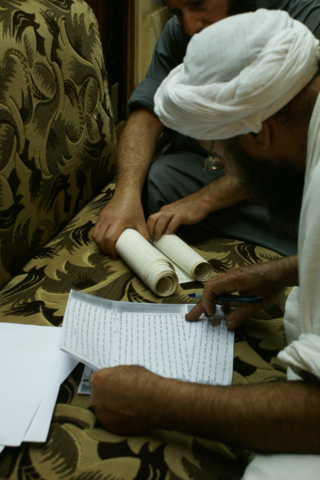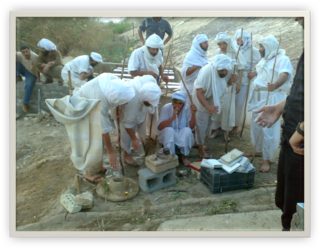In Mandaeism, kushta or kušṭa can have several meanings. Its original literal meaning is "truth" in the Mandaic language, and is thus typically used to refer to the Mandaean religious concept of truth. The same word is also used to refer to a sacred handclasp that is used during Mandaean rituals such as the masbuta, masiqta, and priestly initiation ceremonies.

The Qulasta, also spelled Qolastā in older sources, is a compilation of Mandaean prayers. The Mandaic word qolastā means "collection".

A rasta is a white ceremonial garment that Mandaeans wear during most baptismal rites, religious ceremonies, and during periods of uncleanliness. It signifies the purity of the World of Light. The rasta is worn equally by the laypersons and the priests. If a Mandaean dies in clothes other than a rasta, it is believed that they will not reenter the World of Light, unless the rite "Ahaba ḏ-Mania" can be performed "for those who have died not wearing the ritual garment."
An uthra or ʿutra is a "divine messenger of the light" in Mandaeism. Charles G. Häberl and James F. McGrath translate it as "excellency". Jorunn Jacobsen Buckley defines them as "Lightworld beings, called 'utras ." Aldihisi (2008) compares them to the yazata of Zoroastrianism. According to E. S. Drower, "an 'uthra is an ethereal being, a spirit of light and Life."

The masiqta is a mass or ritual practiced in the Mandaean religion in order to help guide the soul (nišimta) towards the World of Light in Mandaean cosmology. They are typically performed as funerary rites for Mandaeans who have just died. Although usually translated as "death mass", a few types of masiqta are also performed for living people, such as when priests are ordained. Masiqtas are also used to consecrate houses of worship.

The Coronation of the Great Šišlam is a Mandaean religious text. The text is a detailed commentary on the initiation of the tarmida, with detailed discussions on masbuta and masiqta rituals. The Scroll of Exalted Kingship is also used extensively alongside the Coronation in tarmida initiation rituals. Similar esoteric texts that are traditionally used exclusively by Mandaean priests include The Thousand and Twelve Questions, and The Baptism of Hibil Ziwa.

Sheikh (Rabbi) Ganzibra Jabbar Choheili was an Iranian Mandaean priest, the head of the Mandaean Council of Ahvaz, which presides over the Mandaean community of Iran.

A tarmida is a junior priest in Mandaeism. Ganzibras, or head priests, rank above tarmidas.
In Mandaeism, Shishlam is a figure representing the prototypical Mandaean priest or Mandaean. He is also frequently referred to in Mandaean texts as Šišlam Rabba (Classical Mandaic: ࡔࡉࡔࡋࡀࡌ ࡓࡁࡀ, romanized: Šišlam Rba, lit. 'Great Shishlam'. Shishlam is sometimes identified with Adam Kasia, the "Perfect Man".
In Mandaeism, Shitil is an uthra from the World of Light. Shitil is considered to be the Mandaean equivalent of Seth.

In Mandaeism, a shkinta or shkina (škina) is a celestial dwelling inhabited by uthras in the World of Light that is analogous to the shekhinah in Jewish mysticism. In Tibil, it refers to a reed or mud hut that is used during Mandaean priest initiation ceremonies, since Mandaean priests represent uthras on earth.

The drabsha or darfash is the symbol of the Mandaean faith. It is typically translated as 'banner'.
The Scroll of the Ancestors is a Mandaean religious text that describes the rituals of the Ṭabahata (ancestors') masiqta, held during the 5-day Parwanaya festival.

In Mandaeism, the klila is a small myrtle wreath or ring used during Mandaean religious rituals. The klila is a female symbol that complements the taga, a white crown which always takes on masculine symbolism.
A Mandaean priest or Rabbi refers to an ordained religious leader in Mandaeism.

An andiruna is a temporary reed hut used during Mandaean priest initiation ceremonies.

In Mandaeism, the zidqa brikha is a type of ritual meal blessed by Mandaean priests. Zidqa means oblation and can also mean alms, while brikha means blessed. Unlike the lofani, which is a minor ritual meal does not require the presence of a priest, the zidqa brikha needs to be prepared by a priest.

The qabin is the Mandaean wedding ritual. Mandaean weddings are typically held for several days. Traditionally, weddings must be officiated by a Mandaean priest and can only be performed for ethnic Mandaeans, although this has proved to be challenging for the contemporary Mandaean diaspora.

In Mandaeism, riha is incense used for religious rituals. It is offered by Mandaean priests on a ritual clay tray called kinta in order to establish laufa (communion) between humans in Tibil (Earth) and uthras in the World of Light during rituals such as the masbuta (baptism) and masiqta, as well as during priest initiation ceremonies. Various prayers in the Qulasta are recited when incense is offered. Incense must be offered during specific stages of the typically lengthy and complex rituals.
In Mandaeism, Yura is an uthra. Yura is mentioned in Right Ginza 15.7, 15.8, 16.1, and 17.1, as well as in Qulasta prayers 214 and 379.














